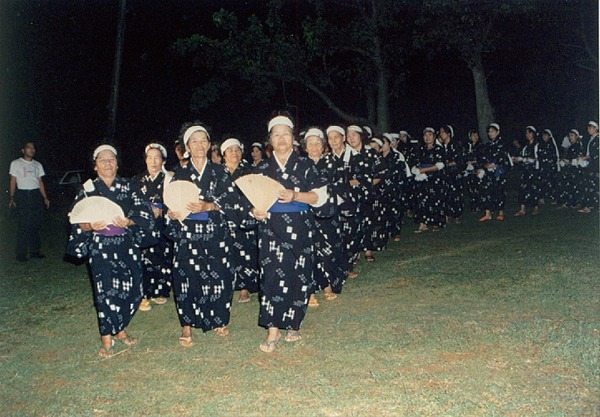トップ > 市の組織 > 教育委員会 > 生涯学習部 > 生涯学習振興課 > 【国指定:選定無形民俗】野原のマストリャー
【国指定:選定無形民俗】野原のマストリャー
〔のばるのますとりゃー〕
旧暦8月15日に、上野地区野原(のばる)で行われる豊年祭である。午前中、大グスク内の拝所で婦人が祈願し、夕方には、4か所のマスムトゥ(貢租を集めた場所)で、酒・肴を囲んで男たちが直会をする。公民館の広場では、青年男子による棒術4組と、婦人の踊りが演じられる。婦人の踊りは数列縦隊になり、前列はくば扇、後列は四つ竹をもって「抱(だ)ぎ踊り」と「投(な)ぎ踊り」で構成されている。最後に巻踊りとクイチャーを踊る。「マストリャーはじめの歌」にこの踊りは普通の踊りではない、地頭主(役職名)の許しを受けて踊るのだ、という意味の歌詞があることから、苦渋に満ちた人頭税時代の面影を反映しているのがわかる。
宮古諸島の芸能の中では特異な民俗芸能である。
【National Designation:Selected Intangible Folk】Masutorya of Nobaru
This is a harvest festival held in Nobaru of the Ueno district on August 15 on the lunar calendar. During the morning hours, the women offer prayers at the place of worship and at dusk, the men have a feast of sake and food at the four Masumutu (where taxes were collected in the past ages). On the grounds of the community center, four groups of young men present their bojutsu performance and the women perform dances. The women line up in rows for the dance performance, with those in the front holding palm fans and the women in the back row clap the Yotsudake bamboos in their hands, in the Dagi Odori and Nagi Odori formation. The last dance performances are the Maki Odori and the Kuicha. The lyrics in the song for the beginning of Masutorya tell of how this is not a regular dance, but a dance permitted by the Jitonushi (an official) and through this song and dance, we can understand the hardships of the people during the period of heavy taxation.
This is a unique folk performance art among the performing arts of the Miyako Islands.
【國家指定:選擇無形民俗】野原的取升舞節(Masutoryaa)
在舊曆8月15日,於上野地區野原舉行的豐年祭。上午,婦女們在大城內的祭拜所祭拜,傍晚,男子們在4處升元(收集貢租的地方)圍著酒菜進行共飲共食的禮儀。在公民館的廣場上,由年輕男子表演4組棒術,婦女們表演舞蹈。婦女們的舞蹈排成幾列縱隊,前列手持蒲扇,後列手抱四竹分別跳「抱舞」和「投舞」,最後是跳卷舞與和聲舞。「取升初舞」不是一般的舞蹈,必須得到地頭主(職稱名)的許可才能跳,歌詞反映了充滿苦惱與悲傷的人頭稅時代。
在宮古諸島的傳統藝能中,屬於很特殊的民俗藝能。
【정부 지정:선택 무형 민속】노바루의 마스토랴
음력 8월 15일에 우에노 지구 노바루에서 지내는 풍년제이다. 오전에는 우후구스쿠 내의 기원 장소에서 여성들이 기도를 올리고 저녁에는 네 군데의 마스무투(조공을 모아놓은 장소)에서 술, 안주와 함께 남성들이 잔치를 벌인다. 마을회관 광장에서는 청년들로 구성된 봉술棒術 4조와 여성들이 춤을 춘다. 여성들의 춤은 수열종대가 되어, 앞 줄에서는 구바오기(비로야자로 된 부채), 뒷줄에서는 요쓰타케(대나무로 된 타악기)를 들고 춤을 추는 “다키 춤”과 “나기 춤”으로 이루어진다. 마지막에 마키 춤과 구이챠 춤을 춘다. “마스토랴 시작 노래”에는 이 춤은 보통 춤이 아니다, 지토누시(직함명)의 승낙하에 추는 춤이다라는 뜻의 가사가 나온다. 고난스러웠던 인두세 시대의 상황을 반영함을 알 수 있다. 미야코제도의 예능 중에서는 특이한 민속 예능이다.
生涯学習部 生涯学習振興課
電話:0980-72-3764






